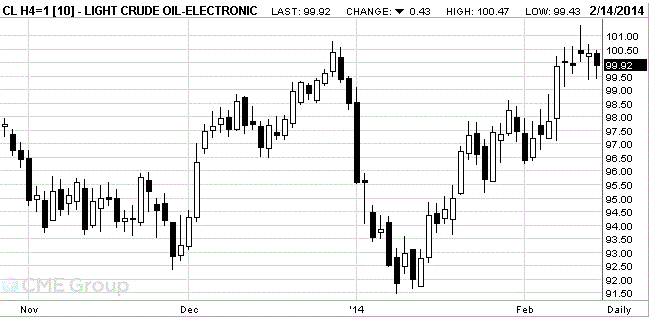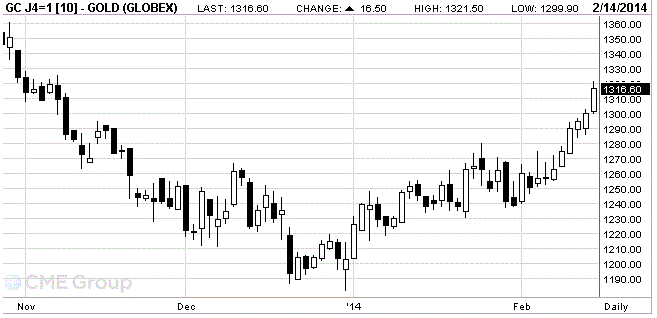Notícias do Mercado
-
16:40
Oil: an overview of the market situation
Oil prices declined moderately today as weak U.S. economic data could compensate for the increase , which was connected to supply disruptions in Libya and Angola.
Experts note that an unexpected drop in U.S. retail sales surge in January and weekly claims for unemployment insurance caused doubts about the accelerating growth in the world's largest economy and undermined expectations of increasing global oil demand growth this year.
" Prices have fallen during today's session , as the weaker outlook for demand in the United States and the decline in producer prices in China have reduced investor interest in buying ," said Kas Kamal , an analyst at Sucden.
Oil experts, however , remain optimistic about global growth in oil demand .
Recall that the report presented today in China showed that consumer prices rose 2.5 percent in January compared with the previous year , registering the same rate of increase as in December. Experts expect that consumer prices will rise by 2.4 percent. On a monthly basis , consumer price inflation accelerated to 1 percent from 0.3 percent a month earlier. For the entire 2013 , inflation was 2.6 percent , well below the government's target of 3.5 per cent .
At the same time , it was reported that producer prices fell by 1.6 percent year on year , compared with a decline of 1.4 percent in December. The rate of decline matched economists' expectations and remain in negative territory for almost two years. On a monthly basis , producer prices fell 0.1 percent in January , while fixing the first drop in the past six months.
On the dynamics of trade also influenced appeal of the International Energy Agency (IEA ) to the Organization of Petroleum Exporting Countries (OPEC) to increase oil production.
Oil stocks in developed countries fell to a 5-year low amid strong demand , and oil prices since the beginning of the year increased by 9 %. In order to cool slightly overheated market , the IEA and OPEC asked to increase production quotas .
Current daily limit supply by OPEC countries - 30 million barrels per day , the actual daily volume of deliveries in January amounted to 29.94 million barrels per day
During the last three months of 2013 oil reserves in the group of OECD countries declined by 1.5 million daily barrels , so quickly reserves are not depleted in 1999.
One of the leaders to increase demand for oil was U.S. . And, as analysts predict this trend will continue for some time .
The other day , OPEC and U.S. Energy Information Administration raised its forecast for global oil demand in 2014. The IEA raised its forecast to a record 92.6 million barrels per day , down 1.3 million barrels a day more than last year .
Traders also respond to data from the U.S. Department of Energy , under which oil reserves rose by 11.1 million barrels over the past four weeks.
March futures price for U.S. light crude oil WTI (Light Sweet Crude Oil) fell to $ 99.92 a barrel on the New York Mercantile Exchange (NYMEX).
March futures price for North Sea Brent crude oil mixture fell 46 cents to $ 108.25 a barrel on the London exchange ICE Futures Europe.

-
16:20
Gold: an overview of the market situation
Gold prices today rose markedly , reaching a three-month high at the same time , and showing its biggest weekly gain in the past six months, as a series of weak U.S. data , which were released this week , have raised concerns about economic growth and put pressure on dollar .
Spot gold prices rose to a high of $ 1,320.90 an ounce, the highest since November 7. For the week, prices rose by 4 per cent , showing the largest increase since mid-August .
" Gold continues to trade very well , punching with one key resistance level after another ," said BofA Merrill Lynch analyst Michael Widmer . " From a fundamental point of view , we can assume that gold will continue its upward trend ."
The technical picture has improved over the past few sessions and prices were above its 200 -day moving average , the last time was registered in August 2012 .
However, some traders noted that the 14 - day relative strength index (RSI) for the spot price of gold was at 73.7 . An index value above 70 indicates that the market is overbought .
Add that with the beginning of the year prices rose by almost 9 percent , after falling 28 percent in 2013 on doubts about the recovery of the U.S. economy , as well as turmoil in emerging markets, which put pressure on some markets .
However , analysts remain cautious about the medium-term prospects for gold. Many expect the U.S. economy to recover and the dollar will start its rally , which would put pressure on gold , which is generally regarded as a safe haven in times of trouble .
We add that the current rise in gold prices has also helped improve sentiment among investors that directly affected the fund SPDR Gold Trust - stocks rose by 7.5 tons to 806.35 tons , registering the largest inflow since late December .
Physical demand , meanwhile, can be reduced in marked increase in prices and the possibility of another fall that keeps buyers at bay.
The cost of the April gold futures on the COMEX today rose to $ 1316.60 per ounce for ounce.

-